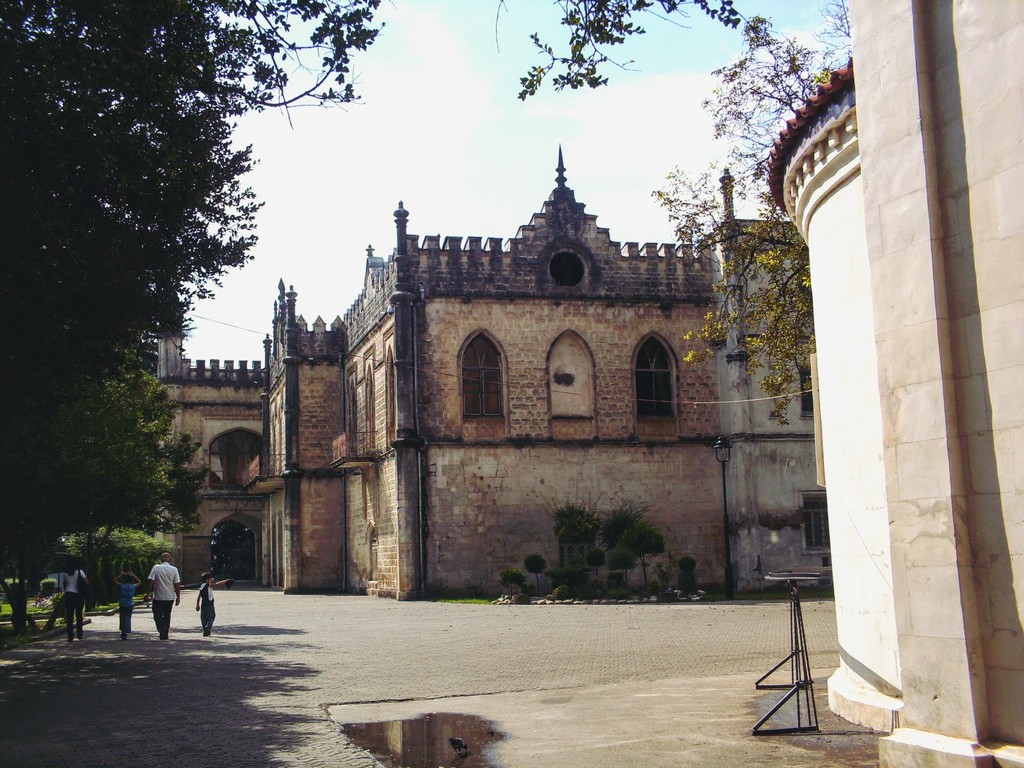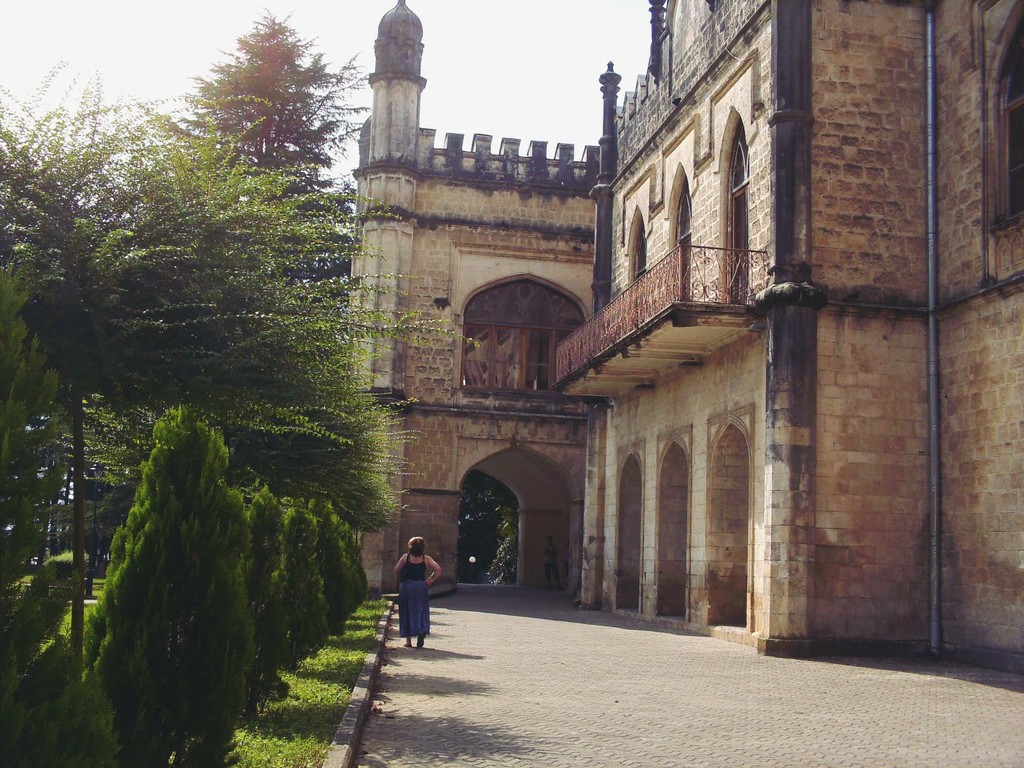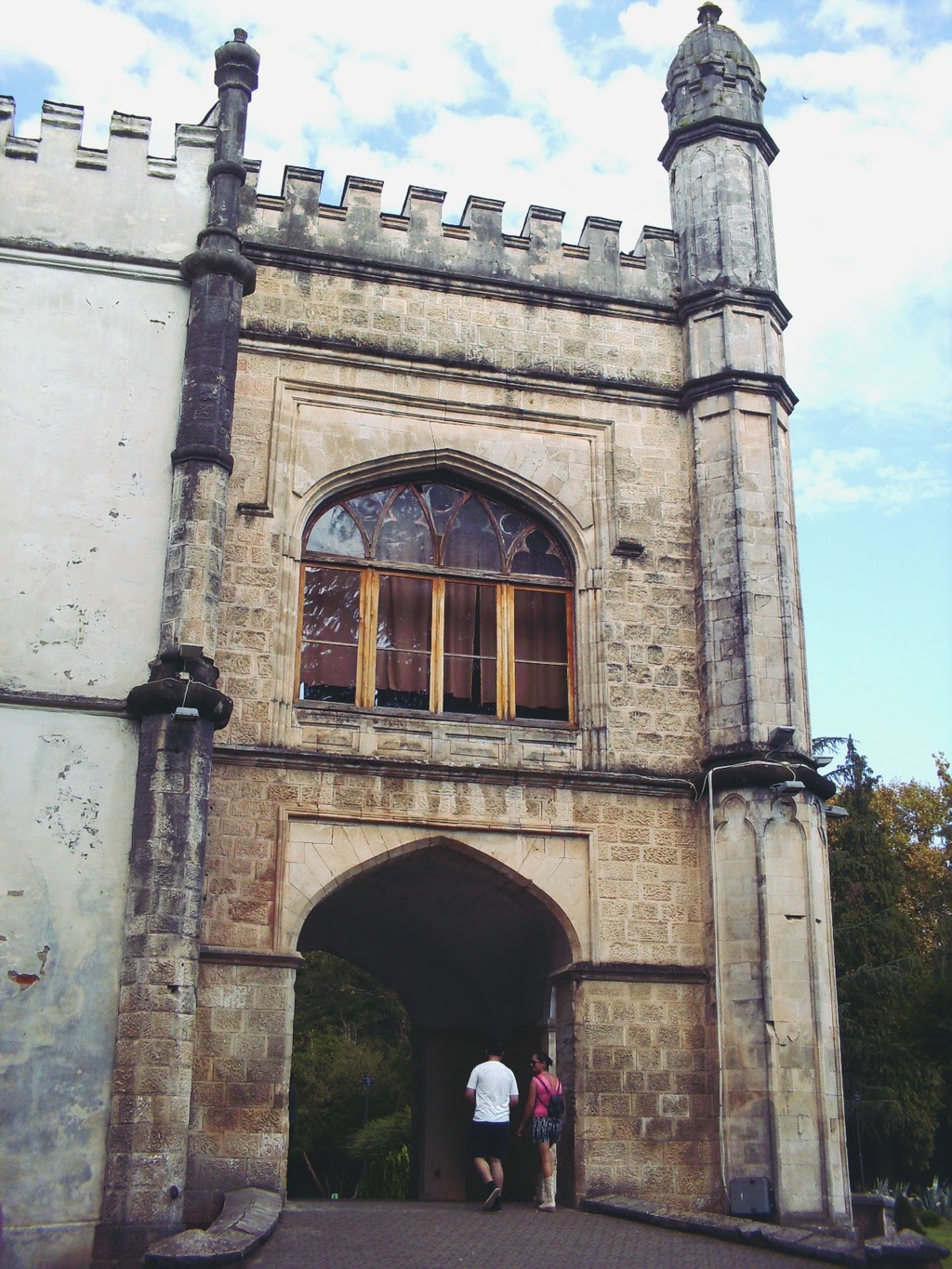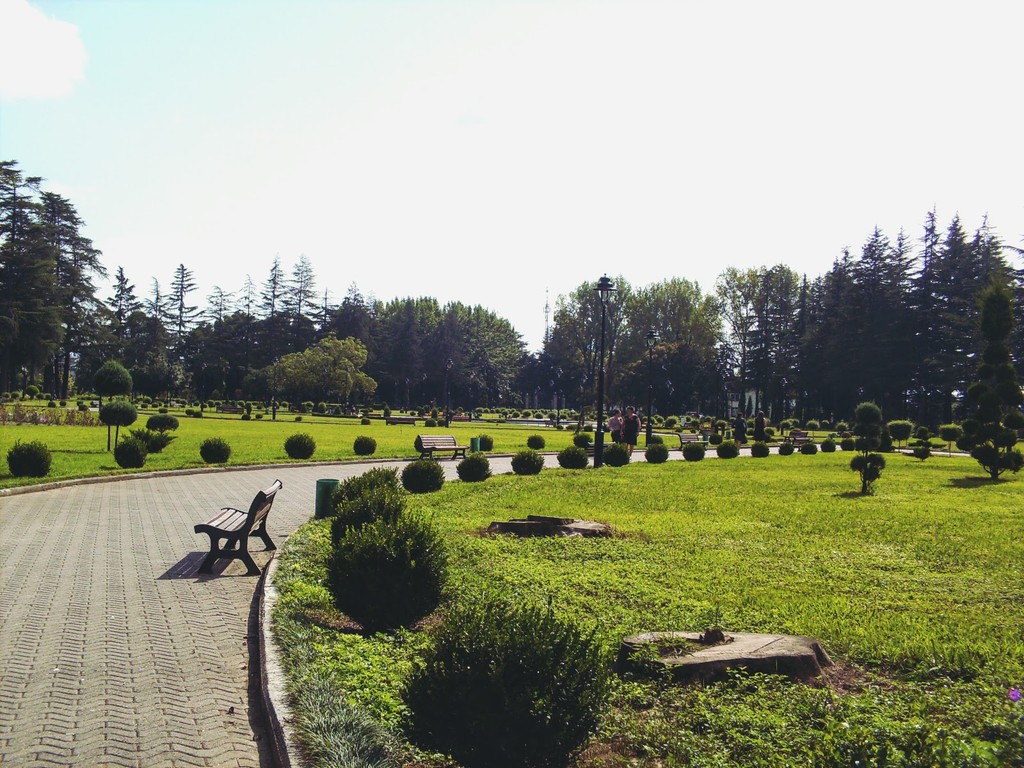Dadiani Palace
Dadiani Palace is a historical building, which is a museum as well. It is located in Zugdidi, _ that is in Samegrelo-Zemo Svaneti region of Georgia. It is one of the most eminent palaces in the whole Caucasus region. It was founded in 1921. This is a splendid palace with all these amazing yard and the ornaments on the walls and the architecture is so wonderful that it reminds you of those movies about the time after some middle ages and stuff like that.

So, the museum was founded in 1921. It consists of two palaces: Queen Ekaterine Chavchavadze-Dadiani Palace and Niko Dadiani Palace, there are also a church and a botanical garden. There is a garden around the museum that covers 67 hectares, where there are many trees and unique trees and bushes grown there. There are about 50, 000 exhibits presented in the museum. Governor Davit Dadiani opened a museum in the palace even in 1850s, and there were antique town _ Archaeopolis (Nokalakevi) archaeological findings, such as numismatic exhibits, European armory from the Middle Ages, ethnographic and art exhibits, etc.
Nowadays museum has 44, 475 exhibits, which include: jewellery from the 1st century BC till the 19th century AD (icons and other religious things, art crafts), exhibits of archaeological findings of antique Greece and ancient Colchis cultures, Christian collection, European applied arts (Rococo, Empire style), governors of Samegrelo, as well as French (there are exceptionally many exhibits in relation to Napoleon Bonaparte, which were brought in the palace by Davit Dadiani brother-in-law, Ashil Miurati), Russian, Spanish emperors’ family members’ relics, hand-written books from the 15-19th centuries, library of Napoleon Bonaparte (6, 000 books) and Dadiani, armory exhibits from Europe and Asia, paintings from Russia, France and England, many photos (5, 000 photos), ceramics, crystal, porcelain, etc. from France, Germany, China, Russia and others.
History of Dadiani Palace
It’s known, that Zugdidi became a residence of governors of Samegrelo during the reign of Levan the 2-nd Dadiani. There are records about that by Arcangelo Lamberti, Jean Chardin, Teramo Cristoforo Castelli. According to Vakhushti Batonishvili, Zugdidi was pretty large town with many inhabitants. As I’ve said earlier, the Dadiani museum complex consists of the Queen Palace, Niko’s Palace, Governor’s Palace and a decorative garden. The Queen’s Palace was renovated in the 1860s by German architect Rice, and until that the building was owned by Pupi _ sister of David governor of Samegrelo. Rice built some arches on the second floor and some other accessories. The palace has a beautiful balcony, which has a unique wooden ceiling, and to make it they used about 10, 000 small wooden details and imagine that’s how this five metres of mosaic was made!
There is a heptagonal geometric figure in the central place of the mosaic, and there are approximately 50, 000 small wooden ornaments used to decorate the whole balcony mosaic! No one really knows, who the architect of the balcony was, but according to people, Ekaterine Chavchavadze the Queen of Samegrelo had the best architects from Lazeti to build the balcony and ordered them to build a masterpiece, something they had not seen anywhere before. They say, every detail is boiled in honey in different temperatures and by that each of them has different colours and that’s why the mosaic of the balcony is amazing to see.
Niko’s Palace was built in the 1880s by a Russian architect Leonid Vasilev. The residence has two floors, and it has a stone balcony and the largest ball room in the whole Georgia.

The collection
The Museum’s collection consists of more than 45, 000 exhibits. Some of them are even from the 1919. Others were added to the palace’s collections later. They describe the historical periods of not only Georgia, but other countries, too and there are many significant and unique exhibits in the museum, such as Napoleon’s mask brought in the museum by Salome Dadiani-Murat. She was married to Napoleon’s nephew Achille Murat. Another significant exhibit of the museum is Virgin Mary’s Robe, and there are many stories about how it appeared in Georgia. The most popular one of them tells us, that when Turks conquered Constantinople, the Robe was taken with other holy pieces by archbishop and brought to Georgia. Every year, in August, the Robe can be seen by visitors, and all the other times it’s kept in so called “Virgin Tower”.
One of the important section of the collection is Dadiani Library, where there are kept hundreds of letters, writings, rare books and even books from Napoleon’s personal library. In 1927 the Soviet Government decided to take the library to Tbilisi, but the museum head Chanturia proved them, that the library was an imperative section of the museum and that it should have stayed there as it was.
Museum’s armory collection has over 200 swords, pistols, guns and other armory and weapons. Most of them were taken from the opponents as booty, and some of them were gifted by Russian Tsars. The furniture in the Palace was made in France and Russia and some of the things are gilded or decorated with ornaments.
There are many other exhibits in the museum, which Dadians have collected over the years. Those are exhibits that once belonged to emperors’ families of China and Japan; also, things from aristocrat families from Russia, Great Britain and other countries. There is also Davit Dadiani’s collection of coins, in which there are some rare coins from antique Rome and Greece.
The museum’s collection was growing even after Dadiani lands were given to the government. Some of the exhibits were collected for the exhibitions, some of them were gathered from archaeological expeditions held by the museum head Chanturia. One of the important archaeological diggings were in 1935, when they found an ancient Colchis remains. It was above the water level, which proves the records of Hippocrates, according to whom the Colchis had a strange lifestyle. The archaeological findings there were transported to Dadiani Museum and are kept there.

Archaeological exhibits
There you can find many early and new Stone Age weapons. There have been found many bronze axes in Zugdidi region and its surroundings. There is especially interesting thing _ a caliber for an axe from the Colchis, which was found on the right embankments of Enguri river, near the village Tagiloni. There are many copper ingots, that states that people used to make bronze weapons and axes, too, locally there. There were archaeological diggings in Zugdidi region near the village Anaklia in 1935-36 years and there were many things found, which gave the scientists some important information about the life in ancient Colchis.
Numismatic collection
There is a numismatic collection in the museum. There you will find Colchis Tetri, Roman, Byzantine, XII-XIX centuries Georgian, Russian, Hungarian, Polish and other coins. The most special ones are the 1st century BC, the 2-d century AD Colchis gold coin and Justinian the 1st’s (527-265 years) coin.
Statues in Dadiani Museum
There are Georgian statues in the museum, which is an image of a pagan idol _ ox. Also there are tens of epigraphic exhibits from the 13-17-th centuries.
There are many historic icons there, one of them is the 12-th century icon of Queen Burdukhan _ mother of Queen Tamar.
The treasure of Zugdidi Dadiani Museum is Virgin Mary’s Robe, which was brought to Georgia in 1453, when the Byzantine Empire fell. It was first brought to Bedia Monastery, and then taken to Khobi Church and then in 1533 Levan the 1st Dadiani brought Virgin Mary’s Robe to the governor palace. This is a great amazement for any Christian to see this Virgin Mary’s Robe with their own eyes.
Besides Virgin Mary’s Robe there are many other holy things in the museum. There are some pieces of Saints, and you may find this surprising, but it’s the truth. So, back in those days people would torture them and cut them into pieces and so on, and then those pieces were brought to different churches and monasteries and kept there. And so, there are some pieces of Saints in the museum. There are St. Marine’s, St. Kvirike’s, St. George’s, St. John the Baptist’s pieces in the museum. Those pieces of Saints’ are put in a silvered small capsule, which is decorated with valuable stones and a gold carving of Virgin Mary’s figure. There is an inscription on the capsule that reads Levan the 2nd Dadiani _ governor of Samegrelo and the Queen Nestan-Darejani.
Archives and records
There are unique books, miniatures and certificates exhibited in the museum archives. One of the special items there is a literature archive, where there are 19-20-th centuries’ letters of Grigol Orbeliani, Platon Ioseliani, Iona Meunargia, Nino Nikoladze, Tedo Zhordania and others. Those are the famous Georgians of those centuries, who did a great work in those years for Georgia.
Armory archive
The very special sector of the museum is the armory archive. There are Russian Emperor’s archives and armory stationery, records of relationships between Russia and Georgia (from the 20-th century, which was a special period of time and which is a very important one to study Georgian social and economical and political history).
So, the governor of Samegrelo _ Davit Dadiani was one of the first to found a museum and he did that in Dadiani Palace. It’s thought, that he had started collecting battle weapons for his collection, and after some time his wife, children and other Dadianis helped to grow the collection.
There are weapons of almost every era of history in the Dadiani Palace armory section. It seems like the collecting thing had started even in the 17th century, but then it was not for a museum purpose. Then, in the 19-th century, when Davit Dadiani decided to make this place a museum, they started collecting things for this purpose. So, they collected weapons with a kind of a tactic and, hence, we can divide this collection into some groups, such as Caucasus side-arms, Caucasus fire-arms, Russian side-arms and fire-arms, European, Asian, African and Australian weapons, spears and crossbows, bombs and mortars, battle medals, helmets, armour, defense weapons, saddles and valuable memorial weapons.
Of course, the most part of the collection consists of Caucasus side-arms and fire-arms. There are Georgian weapons made in the 18-19th centuries, which have many ornaments in Iranian or cross style. Almost on every Georgian weapon we see every detail decorated, they are either decorated on surface or carved. During carving the master put silver or brass wires in an already prepared fissures, and during the surface decorations, he put the wires on the surface of the weapon. For example, Georgian sword had a massive body with a sharpening on one-side or on both sides and a sulcus in the middle of it and it kind of divided the sword into two parts, and this made the sword lighter and more flexible. Very often there was an inscription made on the sword or a writing about the owner or something. The lengths of the swords exhibited in the museum range from 44 centimetres to 100 centimetres.
One of the finest swords in the museum is a sword with a hallmark. Its length is 110 centimetres and the width is 8 centimetres. The sheath is reverted with mother-of-pearls and two silver pyramids. There is a five-headed giant “Devi” carved in the end of the sword. There is also carved Phalos, a fertility and strength symbol.
There are also Caucasian people’s weapons and the Dagestan and Circassian ones are really special.
In general, Dagestan was called “Caucasian Weapon Smithery”. Dagestan craftsmen made guns and swords. And gold-smiths made extraordinary patinas and stuff. There were some regions mastered in making side-arms, and some were mastered in making fire-arms, and some were mastered in both. There were whole villages making weapons and some of the villages provided weapons for the whole Caucasus. The weapons exhibited in the museum are from the 18-19-th centuries and they have a special characteristics, such as strictly stylized ornaments like leaves, beautiful bouquets, etc. The handle was made from silver, horns or bones. In most cases, the sword was a little bit bent and it is sharpened on one side only. There is one sword in the museum, on which there are lines from Quran in Arabian language.
In contrast with Dagestan swords, Circassian ones are not many in the museum. And most of them are not hallmarked, so it’s unknown where they came from. Just some ornaments help us identify some of them. As it’s known, Circassians were fond of ornaments with plants inside geometric figures. Comparing to Dagestan swords, Circassian ones are narrower and the sharpening is a little awry. As I’ve mentioned, Circassian hallmarks are pretty rare. And one of them is in Dadiani museum. There is graphed an equestrian hussar with a sword in his hand with Latin “V. Hussar” meaning “Vival Hussar”. That is a Prussian hallmark, which was made during the Seven Years war, in 1756-1763 years, and approximately that time Circassian masters copied it. A sword with that hallmark was characterized with a greater bent of the body and a greater sharpening.
There is a rich collection of Caucasus fire-arms in Dadiani museum, which consists of hunting and battling weapons and guns and pistols. Most of the guns are from the second half of the 18th century and the 19th century. In that period of time they made fire-arms with wick and flint trigger mechanisms, too. The very important part and so called “pride” of a gun or a pistol was the barrel, of course. So they especially chose steel for the barrel, and they had this steel purchased in Damasco or Turkey. The barrel was decorated with patina or was gilded and its elongated shape got thicker to the butt. Guns in Dadiani museum were mostly owned by Davit the governor of Samegrelo and his sons _ Niko and Andria Dadians, however there are several exhibits, that are of other nobles of Samegrelo. Besides the artistic importance, the exhibits have historical meaning, too. With them Georgians fought in Kars and Erzrum in 1828-1829 years. And in the Crimea war and when Samegrelo fought against Ottoman Turkey and won. Those weapons have also seen the Balkans epopee, in which Megrelian noble Niko Dadiani is well-known for his bravery and heroism.
There is armory of Caucasus fifth regular shooting battalion, too. This battalion was formed in 1899. For successes against highlanders the battalion got five highest imperial awards. This was an elite group, and by the order or the empire’s highest commanders, only Georgians could serve there.
You can see Queen Ekaterine Chavchavadze-Dadiani’s two swords in the museum. As it’s known, armored Queen guided Georgian liberating army against Ottomans herself in 1855. The swords are massive. One of them is 105 centimetres long as a whole and it’s 89, 5 centimetres long without sheath. It’s decorated with ornaments of flowers and leaves, black patina and metal. There is also David Dadiani’s sword, which was gifted to him by his mother.
The collection also has Dadians’ son-in-law, Achill Charles Louis Murat’s sword, who was a descendant of Napoleon the 1-st and Joachim-Napoleon Murat King of Naples. The sword’s length is 111 centimetres with sheath and it has flowers and daisies ornamented on it, and its handle is of crocodile’s skin.
There are also many spears in the collection. There is this Georgian spear _ Gorda, which was only in Georgia. It is a double-sided spear with all the four sides sharpened and one could cut a man into two halves with it. There are also spear from Madagascar, an arrow from Manchuria and an Australian stoke. It’s thought, that the African exhibits were brought there in the palace by the Murats. It’s known, that Achill and Napoleon Murats were in an army in Algeria and Madagascar, and Napoleon became a military officer for his bravery in Madagascar. The exclusive exhibit in the museum is an arbalest or a crossbow. It’s made in the 19-th century and it seems like it was made in England.

Art collection
There is a rococo, Empire style furniture, as well as Georgian, Chinese, Japanese, French, Russian applied arts’ exhibits. There is an engraving of Raffaello Sanzio’s painting “Transfiguration” of the 19-th century. And many other things, mostly from France. There are also: The Russian Leib Cavalery Helmet: "The faith and devotion", the clock of Andria Dadiani With ancestral emblem from the 19-th century England, The buckingam Palace, table "The coronation of Napoleon I" by Jeac Luis David, Achil Murat's saucer with heraldic, etc.
Napoleon Bonaparte’s mask
One of the famous things there in Dadiani Museum is Napoleon Bonaparte’s (1769-1821) bronze mask, which was casted by anatomy professor Francesco Antomarchi (1780-1838) in Paris in 1833. The mask has an inscription on it’s neck, that reads its maker’s name “doctor F. Anromarchi”. There are names of craftsmen on the left “L. Richard and Kennel, and the place of casting _ “Paris”. There is a medallion on the neck with a writing “Napoleon _ the emperor and the King”, also “F. Artomarchi” and the casting year “1833”.

About Dadians
There were many generations of Dadians, who built palaces, fortresses, churches and residences in Georgia and in other regions, too. However, most of them were destroyed and all we have from them are some recordings, descriptions and things like that about those buildings. The Dadiani Palace is one of the splendid examples of the royal architecture in Georgia. The very thorough description on the residence of Dadiani during the reign of Levan the 2nd Dadiani (1611-1657 years) is by the Catholic missionary Don Cristoforo Castelli. He has described the building to be a massive, three-stored building with double roofing and different sized and shaped 17 windows, two balconies and a small building with a tower. There was also a bell tower and a church beside it. The complex building reached its peak in the 19th century and then was it when there were some fascinating buildings built, such as Davit Dadiani Palace, Queen Ekaterine Palace, Murats’ Palace, botanical garden, etc. Despite the fact, that the buildings were newly built, most of them were destroyed during battles, fires and the regime of the Soviet Union and its ignorance.
Davit Dadiani Palace
Davit Dadiani was the last governor of Samegrelo. The remains of the palace are still left. It was situated near the main entrance of the botanical garden. The building was finished in the early 19-th century, and it consisted of 28 rooms and its central part was built in stones. In 1855 the palace was invaded and turned into a war hospital by the army of Turkish general Omar Pasha. When the Megrelians liberated Zugdidi, the Turks set the palace on fire and fled. It was then rebuilt and renovated and there was sat a governor or Russian Empire. Soon after that the palace was once again set on fire and destroyed. It was not rebuilt then. Instead, its stones were used to build Niko Dadiani’s Palace.
Botanical garden
The botanical garden covered a vast territory. It was constructed by an Italian landscape architect Joseph Babini. It consisted of an orangery, labyrinth, nursery, greenhouse, and an artificial lake. There were many exotic plants brought from all over the world, and among them there was a wonderful rose collection. There was a competition in the Russian Empire in 1840 to determine the best park in the empire and Dadiani botanical garden took the first place. Davit Dadiani dedicated this garden to his wife Ekaterine, who participated in the constructions herself. After the Turks fled, they destroyed the garden, too.
Murats’ Palace
This was a palace, where Ekaterine’s daughter Salome lived with his French husband Achill Murat. The palace was mainly built with wood, and it consisted of 24 rooms. The palace no longer exists, but there is an old photo of it, and we can see that it has been a lovely palace in a characterized style of that period. There was a fire that destroyed it in 1895. Soon after the fire Achill Murat dies in his summer residence in the village Chkadua. There were many stories about his death and no one really knows what happened.
Queen Ekateine’s Palace
The building of the famous palace started in 1873. The architect was Edwig Jacob Rice. The building has been kept and it’s in a great shape. The museum is in this building nowadays. It resembles the Alupka Palace in the Crimean mountains. Both of the buildings are built in Neo-Gothic style and they are pretty vast. All in all, they remind us of English castles with a little eastern look. The interior is decorated perfectly, too. There are Georgian, Russian and Paris styles in there. The palace has a three-stored tower in an English styled architecture and it is known as the “Virgin Tower” and there they keep Virgin Mary’s Robe.
The balcony of the inner yard is called “the Queen’s Balcony” and it surrounds the whole building and it’s built in wood. It has 51 massive pillars to hold it without any nails! This is just fascinating! And its ornaments consist of over 50, 000 very small incrustations. The balcony was renovated in 1980 and it got its first look more or less.
Back in those days the Queen’s Palace was not just a residence of the governor and the queen. There was also one of the greatest libraries of Georgia in the palace, as well as a museum and military department. There were valuable art exhibits kept in the palace with historical, archaeological and paleographical things.
Niko Dadiani’s Palace
Niko Dadiani was son of Davit and Ekaterine and his palace was built in the 1880s beside the Queen’s Palace by a Russian architect Leonid Vasilev. He was able to mix Georgian interior with Russian exterior perfectly and made something new and unusual for that time.
The palace has a historical meaning, too. There were often held royal meetings, where there were famous representatives of Georgian art and literature. There were discussions about many topics of culture and things like that.
The palace is spectacular in winter, in snow, in particular. So, if you visit it during the snow period and while snowing, there you will see a picturesque landscape of Dadiani Palace before your eyes!

Photo gallery
Content available in other languages
- Español: Palacio de Dadiani
- Italiano: Palazzo Dadiani
Want to have your own Erasmus blog?
If you are experiencing living abroad, you're an avid traveller or want to promote the city where you live... create your own blog and share your adventures!
I want to create my Erasmus blog! →









Comments (2 comments)
This is a very good article and really interesting. Great job!
Thank you!